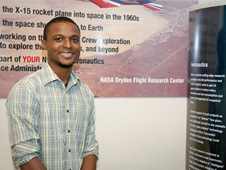 Travis Whitlow – North Carolina A&T engineering student interns at NASA field center during summer EDWARDS, Calif. – EDWARDS, Calif. – North Carolina A&T State University mechanical engineering student Travis Whitlow completed a NASA University Research Centers internship in August 2011 that offered him hands-on and mentored engineering experience at NASA’s Dryden Flight Research Center, Edwards, Calif.
Travis Whitlow – North Carolina A&T engineering student interns at NASA field center during summer EDWARDS, Calif. – EDWARDS, Calif. – North Carolina A&T State University mechanical engineering student Travis Whitlow completed a NASA University Research Centers internship in August 2011 that offered him hands-on and mentored engineering experience at NASA’s Dryden Flight Research Center, Edwards, Calif.
During his two-month summer internship, Whitlow worked with a team of engineers to test and verify strain data that measure mechanical deformation on test articles via fiber optic strain sensing that uses math equations developed at Dryden. His job was to calculate the shape of the test article – information obtained from data gathered through fiber optic shape sensing – and verify that the equations were accurate.
“My time here at Dryden has been the most memorable of all my internships,” Whitlow said. “I was able to contribute to some amazing research and learn a lot in the process. My mentors were great. I am definitely motivated to pursue a career in the aerospace field and this experience has prepared me to do so. I look forward to having another opportunity to visit NASA in the near future. “I became interested in engineering when I learned about the discoveries and advances that have been made possible through work done in that field. I felt that I could somehow contribute to making our everyday lives better. After working with NASA, building and flying small aircraft has become a hobby; staying up-to-date on next-generation aircraft has also become an interest.”
“Travis worked with the NASA Dryden team to aid in the development and validation of a fiber optics shape-sensing algorithm,” said Whitlow’s mentor, NASA Dryden engineer Allen Parker. “He effectively implemented this algorithm through custom software to provide a simulation tool to validate the accuracy of the algorithm. This tool gives our team here at Dryden a ‘second set of eyes’ to use in the development of next-generation methods for interpreting information gathered through fiber optic sensing technology.”
Dryden engineer Patrick “Hon” Chan supervised Whitlow.
“During his summer stay, Travis had independently written a simple software program for strain-to-shape conversion and confirmed that the shape-sensing algorithm worked,” Chan said.
NASA’s University Research Centers program comprises minority institutions that specialize in multi-disciplinary studies in science, engineering and commercial research. The centers provide a broad-based, competitive, NASA-related research capability through the nations’ minority institutions, fostering new aerospace science and technology concepts.
For more information on NASA’s University Research Program, go to:
http://search.nasa.gov/search/search.jsp?nasaInclude=URC
For more about NASA Dryden Flight Research Center, visit:
https://www.nasa.gov/centers/dryden
– end –
text-only version of this release
To receive status reports and news releases issued from the Dryden Newsroom electronically, send a blank e-mail message to dfrc-subscribe@newsletters.nasa.gov. To unsubscribe, send a blank e-mail message to dfrc-unsubscribe@newsletters.nasa.gov. The system will confirm your request via e-mail.
Leslie Williams
NASA Dryden Flight Research Center
Phone: (661) 276-3893
leslie.a.williams@nasa.gov
























